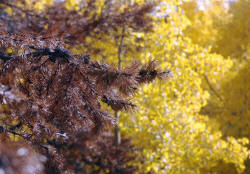|
 Study: Western forests dying at increasing rate Study: Western forests dying at increasing rate
 Send a link to a friend
Send a link to a friend
[January 24, 2009]
GRANTS PASS, Ore. (AP) --
Trees in old growth forests across the West are dying at a small, but increasing rate that scientists conclude is probably caused by longer and hotter summers from a changing climate.
While not noticeable to someone walking through the forests, the death rate is doubling every 17 to 29 years, according to a 52-year study published in the Friday edition of the journal Science. The trend was apparent in trees of all ages, species, and locations.
|
|
 "If current trends continue, forests will become sparser over time," said lead author Phillip J. van Mantgem of the U.S. Geological Survey's Western Ecological Research Center. "If current trends continue, forests will become sparser over time," said lead author Phillip J. van Mantgem of the U.S. Geological Survey's Western Ecological Research Center.
"Eventually this will lead to decreasing tree size," he said. "This is important because it indicates future forests might store less carbon than present."
Old growth forests, particularly those in the Northwest, store large amounts of carbon, making them a resource in combatting global warming, said Jerry Franklin, a professor of forest ecology at the University of Washington. But as trees die, they decompose and give off carbon dioxide, contributing to the amount of greenhouse gases. Young forests store very little carbon, and it takes hundreds of years to replace old growth, he said.
The researchers considered several other possible causes for the higher death rate
- air pollution, overcrowding of young trees, the effects of logging, large trees falling on small ones, and a lack of forest fires, which keep forests healthy. But the data showed the trend affected trees young and old, in polluted and clean air, in crowded and sparse stands and at different elevations.

The likely cause, they concluded, was warmer average temperature across the West, about 1 degree over the study period, said co-author Nathan L. Stephenson, also of the USGS Western Ecological Research Center. That results in greater stress on the trees from lack of water, leaving them vulnerable to disease and insects.
Stephenson said the rising death rate could also produce a cascading decline in forests that leads to less habitat for fish and wildlife, an increased risk of wildfires, and a vulnerability to sudden forest die-offs.
"If it's a gradual process, we may be fine," said Mark E. Harmon, professor of forest ecology at Oregon State University. "If it is a real sudden process, it could be problematical."
[to top of second column] |
 Barbara Bond, a professor of forest physiology at Oregon State who was not involved in the study, said it would be wrong to definitively conclude that the rising tree mortality was caused by warmer temperatures.
"An enormous amount of additional work would have be done before any rational scientist would draw some cause and effect," she said.
The geological survey paid for the study, which examined data between 1955 and 2007 in 76 research plots in British Columbia, Washington, Oregon, California, Idaho, Colorado and Arizona. The average age of the forests examined was about 450 years, with some as old as 1,000 years. Of the 59,736 trees counted, 11,095 died over the study period.
The death rate increase varied, with the highest in California's Sierras, from about 0.9 percent in 1980 and rising to about 1.3 percent.
[Associated
Press; By JEFF BARNARD]
Copyright 2009 The Associated
Press. All rights reserved. This material may not be published,
broadcast, rewritten or redistributed.

 |